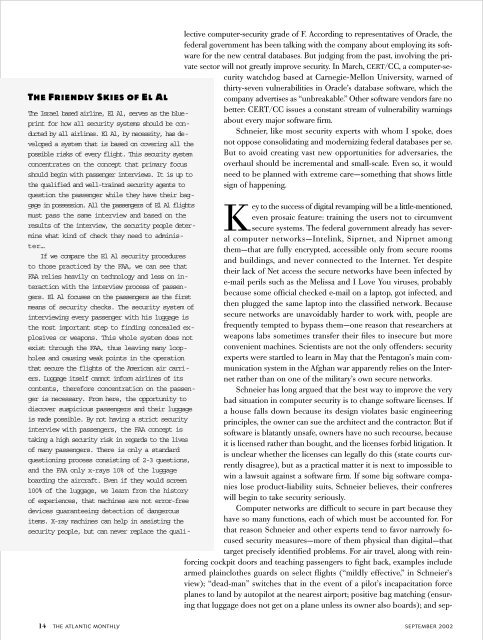HOMELAND INSECURITY - Charles C. Mann
HOMELAND INSECURITY - Charles C. Mann
HOMELAND INSECURITY - Charles C. Mann
You also want an ePaper? Increase the reach of your titles
YUMPU automatically turns print PDFs into web optimized ePapers that Google loves.
Sept-Insecurity.pages 6/28/02 10:37 AM Page 14<br />
THE FRIENDLY SKIES OF E L AL<br />
The Israel based airline, El Al, serves as the blueprint<br />
for how all security systems should be conducted<br />
by all airlines. El Al, by necessity, has developed<br />
a system that is based on covering all the<br />
possible risks of every flight. This security system<br />
concentrates on the concept that primary focus<br />
should begin with passenger interviews. It is up to<br />
the qualified and well-trained security agents to<br />
question the passenger while they have their baggage<br />
in possession. All the passengers of El Al flights<br />
must pass the same interview and based on the<br />
results of the interview, the security people determine<br />
what kind of check they need to administer…<br />
If we compare the El Al security procedures<br />
to those practiced by the FAA, we can see that<br />
FAA relies heavily on technology and less on interaction<br />
with the interview process of passengers.<br />
El Al focuses on the passengers as the first<br />
means of security checks. The security system of<br />
interviewing every passenger with his luggage is<br />
the most important step to finding concealed explosives<br />
or weapons. This whole system does not<br />
exist through the FAA, thus leaving many loopholes<br />
and causing weak points in the operation<br />
that secure the flights of the American air carriers.<br />
Luggage itself cannot inform airlines of its<br />
contents, therefore concentration on the passenger<br />
is necessary. From here, the opportunity to<br />
discover suspicious passengers and their luggage<br />
is made possible. By not having a strict security<br />
interview with passengers, the FAA concept is<br />
taking a high security risk in regards to the lives<br />
of many passengers. There is only a standard<br />
questioning process consisting of 2-3 questions,<br />
and the FAA only x-rays 10% of the luggage<br />
boarding the aircraft. Even if they would screen<br />
100% of the luggage, we learn from the history<br />
of experiences, that machines are not error-free<br />
devices guaranteeing detection of dangerous<br />
items. X-ray machines can help in assisting the<br />
security people, but can never replace the quali-<br />
lective computer-security grade of F. According to representatives of Oracle, the<br />
federal government has been talking with the company about employing its software<br />
for the new central databases. But judging from the past, involving the private<br />
sector will not greatly improve security. In March, CERT/CC, a computer-security<br />
watchdog based at Carnegie-Mellon University, warned of<br />
thirty-seven vulnerabilities in Oracle’s database software, which the<br />
company advertises as “unbreakable.” Other software vendors fare no<br />
better: CERT/CC issues a constant stream of vulnerability warnings<br />
about every major software firm.<br />
Schneier, like most security experts with whom I spoke, does<br />
not oppose consolidating and modernizing federal databases per se.<br />
But to avoid creating vast new opportunities for adversaries, the<br />
overhaul should be incremental and small-scale. Even so, it would<br />
need to be planned with extreme care—something that shows little<br />
sign of happening.<br />
Key to the success of digital revamping will be a little-mentioned,<br />
even prosaic feature: training the users not to circumvent<br />
secure systems. The federal government already has several<br />
computer networks—Intelink, Siprnet, and Niprnet among<br />
them—that are fully encrypted, accessible only from secure rooms<br />
and buildings, and never connected to the Internet. Yet despite<br />
their lack of Net access the secure networks have been infected by<br />
e-mail perils such as the Melissa and I Love You viruses, probably<br />
because some official checked e-mail on a laptop, got infected, and<br />
then plugged the same laptop into the classified network. Because<br />
secure networks are unavoidably harder to work with, people are<br />
frequently tempted to bypass them—one reason that researchers at<br />
weapons labs sometimes transfer their files to insecure but more<br />
convenient machines. Scientists are not the only offenders: security<br />
experts were startled to learn in May that the Pentagon’s main communication<br />
system in the Afghan war apparently relies on the Internet<br />
rather than on one of the military’s own secure networks.<br />
Schneier has long argued that the best way to improve the very<br />
bad situation in computer security is to change software licenses. If<br />
a house falls down because its design violates basic engineering<br />
principles, the owner can sue the architect and the contractor. But if<br />
software is blatantly unsafe, owners have no such recourse, because<br />
it is licensed rather than bought, and the licenses forbid litigation. It<br />
is unclear whether the licenses can legally do this (state courts currently<br />
disagree), but as a practical matter it is next to impossible to<br />
win a lawsuit against a software firm. If some big software companies<br />
lose product-liability suits, Schneier believes, their confreres<br />
will begin to take security seriously.<br />
Computer networks are difficult to secure in part because they<br />
have so many functions, each of which must be accounted for. For<br />
that reason Schneier and other experts tend to favor narrowly focused<br />
security measures—more of them physical than digital—that<br />
target precisely identified problems. For air travel, along with reinforcing<br />
cockpit doors and teaching passengers to fight back, examples include<br />
armed plainclothes guards on select flights (“mildly effective,” in Schneier’s<br />
view); “dead-man” switches that in the event of a pilot’s incapacitation force<br />
planes to land by autopilot at the nearest airport; positive bag matching (ensuring<br />
that luggage does not get on a plane unless its owner also boards); and sep-<br />
14 THE ATLANTIC MONTHLY SEPTEMBER 2002




